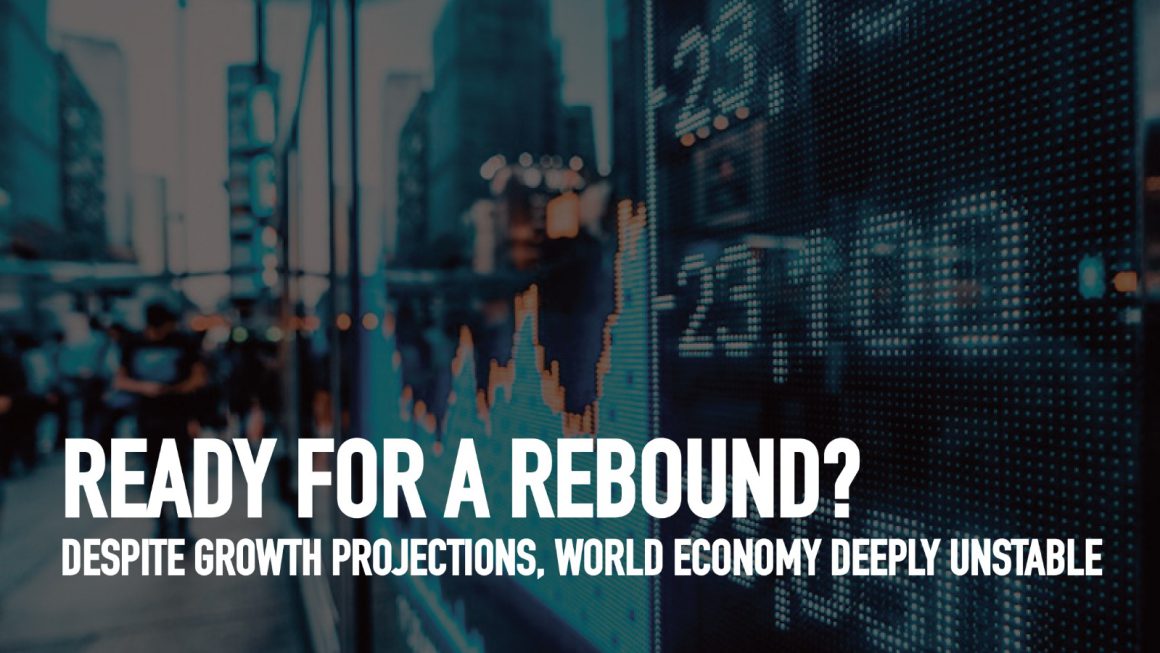By Tom Crean
The devastation caused by the pandemic-triggered global downturn in 2020 is hard to overstate. It was the biggest economic contraction since the Great Depression of the 1930s. Across the world, working hours equivalent to 255 million jobs were lost. The World Bank estimates that the number of people in “deep poverty,” defined as living on less than $1.90 per day, has risen by a staggering 119–124 million people.
But not everyone suffered. According to an analysis by Forbes magazine, the wealth of the world’s billionaires grew by $1.9 trillion in 2020! Inequality, both within nations and between rich countries and the “developing” world, has grown significantly.
However, capitalist economists have now become optimistic about the prospects for global recovery in 2021. The Organization for Economic Cooperation and Development (OECD) recently projected global economic growth of 5.6% in 2021 after a contraction of 3.5% in 2020. This estimate for 2021 is up 1.4% from their November projection. A full 1% of the additional estimated global growth is attributed to the $1.9 trillion stimulus bill passed by the U.S. Congress earlier this month.
This projection is based on a number of very optimistic assumptions which must be questioned. It also leaves all of the underlying contradictions of contemporary capitalism unaddressed. The recovery, based heavily on unprecedented and unsustainable fiscal and monetary injections, will be very unevenly spread and will likely be of short duration before the depressionary trend in the world economy reasserts itself.
Pandemic perspectives
Projections for the world economy cannot be separated, of course, from the course of the pandemic and progress in vaccinating the population. Some of the most wealthy countries, particularly the United States and Britain (as well as Israel), have made big strides in vaccinating their population after a disastrous mishandling of the pandemic. About a third of U.S. adults and more than half of UK adults have now received at least one dose of a vaccine. This raises the prospect of a more extensive reopening and “return to normal” by summer.
In general the OECD’s growth projections are based on optimistic assumptions about the further course of the pandemic. But even in the weeks since the OECD announcement, we see again how the failures of capitalist governments to contain the virus and to develop a rational global plan for vaccination continue to create new dangers for the health of the world population and for economic recovery.
The situation in the European Union (EU) is very telling. Last fall, the capitalist media hailed the EU as a comparative success story among the more wealthy nations, especially compared to the U.S. and UK. But the EU now lags significantly in the race to vaccinate with only 12% of the German population, for example, having received at least one dose. This is partly the result of supply interruptions on top of a failure to secure supplies at an early stage, compounded by an extremely incompetent distribution process. Then came the grossly bungled scare about the AstraZeneca vaccine in Europe which saw vaccination stop altogether for several days before resuming, with several European countries still blocking or restricting its use. This only succeeded in contributing to massive vaccine skepticism. All of this came in the middle of a disastrous new wave of the pandemic in Europe which is leading to a new wave of lockdowns.
Besides being a huge blow to the prestige of EU leaders like Merkel and Macron, the vaccination chaos combined with the new COVID wave have dealt another blow to the European economy and placed a big question mark over the ability to reopen tourism fully this summer. The EU economy is now projected to shrink by 1.5% in the first quarter of 2021 (revised down from a 0.8% contraction), meaning the EU is currently in a “double dip” recession.
Outside of the wealthy countries, the pace of vaccination is even slower and in many countries has not even begun. At the current pace it is estimated that it would take years to vaccinate the world population. There is now a new wave of the pandemic in India while in Brazil, the spread of dangerous new variants and the criminal negligence of the Bolsonaro regime are straining the healthcare system to the point of collapse.
From the beginning, the response to the pandemic has been undermined by healthcare systems which even in relatively wealthy areas like Northern Italy have been drastically weakened by decades of neoliberal cuts. This is compounded by the complete failure to have a globally coordinated response and strategy for vaccination. The EU, UK and U.S. imperialists have protected the profits and “intellectual property rights” of the pharmaceutical giants based on their territories and refused to share the recipes for the vaccines for free with the rest of the world which would massively speed up the vaccination drive.
Such a move would not just be in the interests of society but even of the capitalists. The longer the pandemic continues unabated in large parts of the world the more the opportunity exists for even more dangerous variants to develop which can restart the pandemic. But this rational course of action is blocked by the competition between the imperialist powers.
So instead we have the spectacle of “vaccine nationalism.” On the one hand there is vaccine hoarding with the EU imposing export controls and India, a major vaccine producer, banning exports for now. The U.S. is likely to be sitting on a massive stockpile of vaccines in the coming months but has made very few commitments to share the excess with other countries. Meanwhile China and Russia have used donations of vaccine supply to particular countries part of their diplomatic offensive in the new Cold War with the U.S. The U.S., India, Australia and Japan who collectively act as “the Quad” in security matters have responded with a plan to produce a billion doses of the vaccine in India, financed by the U.S. for Southeast Asia, transparently an attempt to counteract Chinese vaccine diplomacy.
The difficulties of reaching herd immunity due to the total failure to have a global approach to a global crisis and the danger of more deadly variants point to the potential for serious complications with the growth perspective outlined by the OECD.
The Effect of U.S. Stimulus on World Economy
However, barring disastrous short-term developments, wealthy countries — particularly those with rapid vaccine roll outs — will see their economies reopen more or less rapidly during the course of 2021 and a significant rebound is likely. After an economic collapse in 2020 affecting 93 countries, growth figures will look more impressive than they really are.
A key factor in the projections for global growth is the pent-up demand in a number of wealthy countries. Sections of the population, especially parts of the middle class, saved money during the pandemic due to working from home and not traveling. The biggest contributor, however, to pent-up demand is the massive stimulus measures passed in a number of countries. While the stimulus measures in the U.S. since the pandemic began have been equivalent to 27% of GDP, Germany’s are equivalent to 20% and Japan’s measures are probably equivalent to 30%.
But clearly the new U.S. stimulus package is of particular international importance. It is equivalent to a staggering 9% of U.S. GDP; the U.S. national economy is now forecast by the OECD to grow by 6.5% this year, a level of growth unseen since the early 80s. The knock on effects of increased U.S. demand on key U.S. trading partners including Canada and Mexico, but also China and the European Union, are also significant. Last year, demand from wealthy countries for PPE, computers, exercise equipment and various other consumer durables contributed massively to Chinese exports, enabling China to be the only major economy to post nominal growth, even if the economy’s performance has been significantly exaggerated by the regime. Based on the new U.S. stimulus package, UBS bank has upgraded its forecast for China’s export growth this year from 10% to 16%.
There is a lot of discussion in the financial pages of major bourgeois publications about whether the stimulus bill will lead to higher inflation in the U.S. and force the Federal Reserve to raise interest rates to cut across an “overheating” economy. The Biden stimulus and previous stimulus packages in 2020 were all financed exclusively by borrowing. After decades of using the specter of inflation to justify austerity measures the Federal Reserve and the U.S. Treasury Department have done a 180 degree turn and now declare that inflation is no longer a major concern. The head of the Fed, Jerome Powell says even if there’s some inflation later this year it will be temporary and will not justify major interest rate hikes.This is significant because if the cost of borrowing were to increase, it could trigger the next recession as well as complicating plans for further stimulus. In fact further measures are likely to be necessary even if they are more targeted while the inevitable attempts to replace stimulus with austerity will risk destabilizing the world economy in the next period.
It must be stressed that the ability of the U.S. to borrow such staggering sums is based on historically low interest rates and low inflation as well as the position of the dollar as the global reserve currency. U.S. imperialism is in the privileged position of being able to access seemingly limitless funds and pay very little for it. As Leon Trotsky said about the policies of the New Deal in the 1930s, they were “an American policy par excellence,” not available to most countries and certainly not to poor countries. And while there can be a certain boost for poorer countries provided by the stimulus measures of wealthy countries it will also tend to further direct investment away from poor countries and exacerbate their own looming debt crises.
Biden has now unveiled a further massive two stage $3–4 trillion infrastructure plan which he claims will be paid for by increasing corporation tax and taxes on the wealthy. While presented as part of a strategy to address climate change and as a jobs program to address historic inequities, it is also very much a part of the deepening Cold War competition with rising Chinese imperialism. But while part of the ruling class will see higher corporation tax as a necessary price to pay to achieve certain strategic goals, this will meet with significant resistance from sections who oppose higher taxes with religious fervor.
The shift away from neoliberal policy
The scale of the measures that have been taken by the U.S. ruling class in this crisis represent a major shift of direction. Referring to the scale of fiscal intervention and the vaccine drive, the Financial Times (3/13/21) recently pointed out:
“Taken together, this burst of government activism carries echoes of Franklin Delano Roosevelt’s New Deal during the Depression, and Lyndon Johnson’s Great Society reforms of the 1960s.
The U.S. president and many Democrats also hope it can become a powerful rebuttal to Ronald Reagan’s totemic comment in August 1986 that ‘the nine most terrifying words in the English language are: “I’m from the government and I’m here to help”.’
“That mantra ushered in a period of deregulation, low taxes, limited domestic spending and a belief in free markets as the main pillars of American economic policymaking. Those recipes began to be challenged after the global financial crisis, although they were partly revived during Donald Trump’s administration. Yet they could not cope with the onslaught of the pandemic, which left Americans yearning for greater involvement from Washington, offering Biden a chance to fill the void.”
The shift away from neoliberal policy by the U.S. elite which the FT is describing is the result of several factors as International Socialist Alternative has pointed out. First of all, this is the second massive crisis to face capitalism in little more than a decade. During the 2008–9 financial crisis, the focus remained on monetary policy, pumping money (particularly through Quantitative Easing) into the financial markets to prop up the banking system. But as the central bankers themselves admit, to have focused solely on monetary policy this time would have been disastrous. National lockdowns created the threat of a collapse of demand and mass destitution which could only be prevented through fiscal intervention on a scale unseen since the New Deal.
Secondly, in the case of the Biden administration, there is a determination to “learn the lessons” of 2008–9. In the view of many liberal economists, the limited stimulus combined with massive austerity in the EU and the U.S. at that time made the subsequent recovery much slower and shallower.
Finally, the U.S. ruling class has seen mass inequality and extreme political polarization contribute to the BLM rebellion last summer and then Trump’s threatened coup and the assault on the Capitol on January 6. They realize that they were in danger of losing control of the situation and making moves to restore confidence in the state is therefore necessary in order to get ahead of the next social explosion.
Situation remains deeply unstable
Is the likely rebound in the world economy the beginning of a more general upturn? Some in the bourgeois media have compared the situation to the aftermath of World War I and the devastating influenza epidemic of 1918–20 which was followed by the “roaring 20s” in the U.S. and Europe.
Such expectations are misplaced. The underlying cause of the current crisis and of the crisis in ‘08-’09 is capitalism’s increasingly parasitic and sclerotic character. During the neoliberal era, beginning at the end of the postwar boom in the late 70s, the capitalist class restored profitability by attacking the public sector and the living standard of working people. They also benefited from the opening up of new markets after the collapse of Stalinism. This led to a massive increase in inequality and undermined the ability of working people to absorb the wealth produced. The result has been a diminishing field for profitable returns on productive investment and declining productivity growth with excess capital being pumped into the financial casino.
The rebound, fueled by massive outlays of state spending, would solve none of these issues. Even in the U.S., while the rebound could bring millions back to work, it will be far from dealing with the devastation caused by the crisis of 2020 including massive indebtedness affecting big sections of the working class, the big drop in labor force participation of women, and the hundreds of thousands of small businesses that will not be reopening.
The rebound is being also paid for by massively increasing the state debt which in the U.S. is now on a scale not seen since World War II. This is not sustainable especially as there is no prospect of an extended period of significant growth. Instead, as in every previous crisis, the ruling class will seek to present the bill for the crisis to the working class in the next period which will only lead to greater immiseration and inequality.
Furthermore, the assumption that inflation and interest rates will remain super low which has allowed for such a massive borrowing spree is ahistorical. Inflation could rise late this year though the overall context globally remains deflationary. But regardless of the Fed’s current assurances, a sharp bout of inflation, even if temporary, could force a rise in interest rates and bring the rebound to a rapid end.
Besides the possibility of “overheating” in the real economy, there is a looming financial crisis which is also fueled by the massive injection of liquidity into the financial markets since March of last year which were also part of preventing an implosion. This has created speculative bubbles in stocks and other assets, including housing.
Another trigger of the next phase of global economic crisis could come from looming debt defaults by a whole series of poor countries who lack the monetary and fiscal tools available to the imperialist countries and have been generally hit far harder by the economic downturn. The situation facing Lebanon is particularly extreme where rampant corruption and dysfunction in the state apparatus has triggered a banking collapse and hyperinflation. Large sections of the population have been pauperized. Such could be the fate of many countries in the next period.
In short there is no basis for a return to a stable situation for capitalism. Governments used unprecedented monetary firepower to avert complete collapse in 2008–9. Now they are using unprecedented fiscal and monetary firepower to deal with this crisis. What do they do when the next crisis hits?
The ISA has characterized this period as depressionary. This does not mean that all trendlines must constantly point downward but rather that there is no path towards stable growth for capitalism. And a depressionary period does not mean that there can’t be temporary upturns as there were even in the Great Depression of the1930s.
Deglobalisation
The depressionary trend is compounded by the trend towards deglobalization. The pandemic put huge stress on global supply chains and exposed massive problems with the “just in time” production model especially in healthcare as countries and regions scrambled to secure access to vital medical supplies. More recently, the Ever Given container ship stuck for a week in the Suez Canal and blocking a vital trade artery at the cost of billons became emblematic of these strains.
The strategic rivalry between the U.S. and China has accelerated the process of economic “decoupling” between the two countries. For years China has consciously sought to use state investment to develop its strength in cutting edge technology. It has sought to secure supplies of key commodities globally and to reinforce strategic industries. The U.S. will now head in the same direction. Already an electronic chip shortage has temporarily shut down a number of U.S. production lines which is fueling discussion about how to secure American supplies of this critical component for manufacturing. All of this points towards several regional supply chains rather than an integrated global system.
Under Trump, the U.S. imposed extensive tariffs on Chinese imports. Some expected these to be reversed or scaled back under Biden. But so far there is no indication of this. Instead the U.S., Canada, Britain and the EU recently imposed sanctions on Chinese officials over their policies toward the Uyghur minority in Xinjiang which led to counter sanctions by China. Now a new Chinese/EU investment deal looks to be in jeopardy. Meanwhile, in China, there are state sanctioned boycotts against foreign retailers who have criticized their policies.
Comparison is now frequently made with the Cold War between the Soviet Union and the U.S. after World War II. But that was a conflict between two competing social systems which were not part of an integrated world market. It also occurred during the biggest economic upswing in capitalism’s history. The situation we find ourselves in today bears more comparison to the period between the two world wars from 1918 to 1939, a period of generalized stagnation for capitalism with increasing and sharpening global rivalries.
A high level of protectionism was also a defining feature of the interwar period, especially of the 1930s. It is of course true that the global economy is far more integrated today and this cannot be easily undone. But the trendline is what is important. The reassertion of national interests and countries being increasingly pulled into two “camps” will further undermine the type of integrated global economy which existed in recent decades. However, the increasing turn of capitalist governments to state intervention and nationalist economic policy will not avert or resolve further crises, any more than it did in the 1930s.
No way out under capitalism
While new variants or further problems with vaccination campaigns can affect the scale of the economic recovery this year, they will not likely stop it completely. But the rebound will be temporary and there are a range of factors that can trigger the next stage of the crisis. And of course any benefits will be spread very unevenly globally.
A temporary recovery can, however, have a positive impact on the class struggle in many countries, giving workers more confidence to take action. In country after country, we have already seen that healthcare workers and educators have been prepared to stand up in spite of their exhaustion.
There is massive anger just at the way degraded healthcare systems have caused so much loss of life and the failure to protect frontline workers during the pandemic. Any attempt to reverse benefits and protections that are keeping people from destitution will provoke serious resistance. The demand for permanent changes to benefit the mass of the population will grow.
The demand for fundamental change will grow even stronger as the effects of climate change worsen. This is the other and even deeper crisis that has been pushed temporarily into the background by the pandemic and the economic crisis.
Seeing the lengths to which capitalism has been prepared to go to save this decaying system will lead tens of millions to ask why we can’t scrap capitalism altogether. All contemporary developments point to the urgent need to enact a rational democratic and global plan based on public ownership of the key economic sectors to address the challenges we face as a species.












